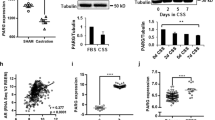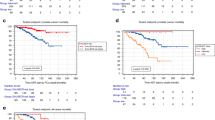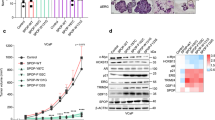Abstract
The androgen receptor (AR) is fundamental to androgen signalling within the prostate gland, and deregulation of its activity is frequently linked to the development of prostate cancer. Advanced prostate cancer is often treated with chemotherapy and most of these drugs exert their function by generating genotoxic stress such as DNA damage. We have investigated here the effects of genotoxic agents used in chemotherapeutic regimens on AR function and expression. We have discovered that endogenous AR activity in LNCaP cells is inhibited in response to the chemotherapeutic agents etoposide and cisplatin. This loss of AR activity is not caused by a change in cell cycle distribution, a change in subcellular localisation of the AR nor by induction of apoptosis. In addition, we found that inhibition of AR activity in response to genotoxic stress is independent of p53 function. Interestingly, our studies revealed that genotoxic stress inhibits the hormone-stimulated recruitment of AR to androgen response elements. Thus, we report for the first time a mechanism by which the AR activity is inhibited in response to different chemotherapeutic agents.
This is a preview of subscription content, access via your institution
Access options
Subscribe to this journal
Receive 50 print issues and online access
$259.00 per year
only $5.18 per issue
Buy this article
- Purchase on Springer Link
- Instant access to full article PDF
Prices may be subject to local taxes which are calculated during checkout







Similar content being viewed by others
References
Black BE, Vitto MJ, Gioeli D, Spencer A, Afshar N, Conaway MR et al. (2004). Mol Endocrinol 18: 834–850.
Bruchovsky N, Wilson JD . (1968). J Biol Chem 243: 2012–2021.
Chen CD, Welsbie DS, Tran C, Baek SH, Chen R, Vessella R et al. (2004). Nat Med 10: 33–39.
Cleutjens KB, van der Korput HA, van Eekelen CC, van Rooij HC, Faber PW, Trapman J . (1997). Mol Endocrinol 11: 148–161.
Cohen GM . (1997). Biochem J 326(Part 1): 1–16.
Cronauer MV, Schulz WA, Burchardt T, Ackermann R, Burchardt M . (2004). Oncogene 23: 3541–3549.
Denmeade SR, Isaacs JT . (2004). Prostate 58: 211–224.
Edwards J, Krishna NS, Grigor KM, Bartlett JM . (2003). Br J Cancer 89: 552–556.
Espinosa E, Zamora P, Feliu J, Gonzalez BM . (2003). Cancer Treat Rev 29: 515–523.
Fang Y, Fliss AE, Robins DM, Caplan AJ . (1996). J Biol Chem 271: 28697–28702.
Feldman BJ, Feldman D . (2001). Nat Rev Cancer 1: 34–45.
Georget V, Terouanne B, Nicolas JC, Sultan C . (2002). Biochemistry 41: 11824–11831.
Gioeli D, Ficarro SB, Kwiek JJ, Aaronson D, Hancock M, Catling AD et al. (2002). J Biol Chem 277: 29304–29314.
Gregory CW, Johnson Jr RT, Mohler JL, French FS, Wilson EM . (2001). Cancer Res 61: 2892–2898.
Gudmundsdottir K, Lord CJ, Witt E, Tutt AN, Ashworth A . (2004). EMBO Rep 5: 989–993.
Hande KR . (1998). Eur J Cancer 34: 1514–1521.
Hoshi S, Ohyama C, Hagisawa S, Ono K, Satoh M, Saito S et al. (2003). Int J Clin Oncol 8: 118–120.
Jordan P, Carmo-Fonseca M . (2000). Cell Mol Life Sci 57: 1229–1235.
Kang Z, Janne OA, Palvimo JJ . (2004). Mol Endocrinol 18: 2633–2648.
Kang Z, Pirskanen A, Janne OA, Palvimo JJ . (2002). J Biol Chem 277: 48366–48371.
Kastan MB, Bartek J . (2004). Nature 432: 316–323.
Komarova EA, Neznanov N, Komarov PG, Chernov MV, Wang K, Gudkov AV . (2003). J Biol Chem 278: 15465–15468.
Lin HK, Yeh S, Kang HY, Chang C . (2001). Proc Natl Acad Sci USA 98: 7200–7205.
Linton KD, Hamdy FC . (2003). Cancer Treat Rev 29: 151–160.
Litvinov IV, De Marzo AM, Isaacs JT . (2003). J Clin Endocrinol Metab 88: 2972–2982.
Louie MC, Yang HQ, Ma AH, Xu W, Zou JX, Kung HJ et al. (2003). Proc Natl Acad Sci USA 100: 2226–2230.
Marcelli M, Ittmann M, Mariani S, Sutherland R, Nigam R, Murthy L et al. (2000). Cancer Res 60: 944–949.
Martinez ED, Danielsen M . (2002). J Biol Chem 277: 29719–29729.
Meek DW . (2004). DNA Repair (Amsterdam) 3: 1049–1056.
Nelson PS, Clegg N, Arnold H, Ferguson C, Bonham M, White J et al. (2002). Proc Natl Acad Sci USA 99: 11890–11895.
Nissen RM, Yamamoto KR . (2000). Genes Dev 14: 2314–2329.
Parker CC, Dearnaley DP . (2003). Cancer Treat Rev 29: 161–169.
Pilat MJ, Kamradt JM, Pienta KJ . (1998). Cancer Metast Rev 17: 373–381.
Rennie PS, Bruchovsky N, Leco KJ, Sheppard PC, McQueen SA, Cheng H et al. (1993). Mol Endocrinol 7: 23–36.
Riegman PH, Vlietstra RJ, van der Korput JA, Brinkmann AO, Trapman J . (1991). Mol Endocrinol 5: 1921–1930.
Rocha S, Campbell KJ, Roche KC, Perkins ND . (2003). BMC Mol Biol 4: 9.
Rosenfeld MG, Glass CK . (2001). J Biol Chem 276: 36865–36868.
Rosenhagen MC, Soti C, Schmidt U, Wochnik GM, Hartl FU, Holsboer F et al. (2003). Mol Endocrinol 17: 1991–2001.
Sack JS, Kish KF, Wang C, Attar RM, Kiefer SE, An Y et al. (2001). Proc Natl Acad Sci USA 98: 4904–4909.
Sciuto R, Festa A, Rea S, Pasqualoni R, Bergomi S, Petrilli G et al. (2002). J Nucl Med 43: 79–86.
Shenk JL, Fisher CJ, Chen SY, Zhou XF, Tillman K, Shemshedini L . (2001). J Biol Chem 276: 38472–38479.
Solit DB, Zheng FF, Drobnjak M, Munster PN, Higgins B, Verbel D et al. (2002). Clin Cancer Res 8: 986–993.
Steineck G, Reuter V, Kelly WK, Frank R, Schwartz L, Scher HI . (2002). Acta Oncol 41: 668–674.
Tyagi RK, Lavrovsky Y, Ahn SC, Song CS, Chatterjee B, Roy AK . (2000). Mol Endocrinol 14: 1162–1174.
Vaishampayan U, Fontana J, Du W, Hussain M . (2004). Am J Clin Oncol 27: 550–554.
Veldscholte J, Ris-Stalpers C, Kuiper GG, Jenster G, Berrevoets C, Claassen E et al. (1990). Biochem Biophys Res Commun 173: 534–540.
Whitesell L, Lindquist SL . (2005). Nat Rev Cancer 5: 761–772.
Wong HY, Burghoorn JA, Van Leeuwen M, De Ruiter PE, Schippers E, Blok LJ et al. (2004). Biochem J 383: 267–276.
Yang J, Yu Y, Hamrick HE, Duerksen-Hughes PJ . (2003). Carcinogenesis 24: 1571–1580.
Acknowledgements
We thank Jenny Titley for assistance with the flow cytometry analysis and Dr Elaine Barrie for fruitful discussions during the preparation of this manuscript. Cancer Research UK [CUK] Grant No. C309/A2187, The Danish Cancer Research Foundation, The Institute of Cancer Research, NCRI South of England Prostate Cancer Collaborative and a short-term EMBO fellowship have funded this work. The PSA61luc, pCMV β-gal and pSUPER constructs were kindly provided by Dr Jan Trapman (Erasmus University, The Netherlands), Dr Julia Bardos (Institute of Cancer Research, UK) and Professor Alan Ashworth (Institute of Cancer Research, UK), respectively. The PC3-wtAR cells were kindly provided by Professor Andrew Cato (Institute of Toxicology and Genetics, Karlsruhe, Germany).
Author information
Authors and Affiliations
Corresponding author
Rights and permissions
About this article
Cite this article
Mantoni, T., Reid, G. & Garrett, M. Androgen receptor activity is inhibited in response to genotoxic agents in a p53-independent manner. Oncogene 25, 3139–3149 (2006). https://doi.org/10.1038/sj.onc.1209347
Received:
Revised:
Accepted:
Published:
Issue Date:
DOI: https://doi.org/10.1038/sj.onc.1209347



